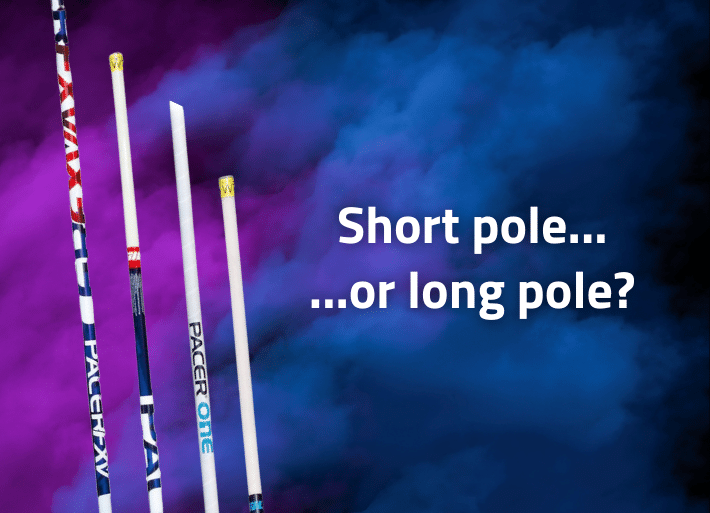
Pacer Vaulting Poles Review
BY OWEN HEARD
As a person who has vaulted on numerous poles, I have always gravitated towards using the Pacer branded ones. Partially because they are what I have always had access to, but also because I love the way they perform during a vault.
Choosing a brand of pole is individual to the athlete, and everyone likes them for different reasons - but I am going to summarise the pros and cons of Pacer poles and why they are my go-to's.
WHAT ARE PACER VAULTING POLES MADE OF?

Pacer vaulting poles currently come in 3 styles:
- Pacer One - Fibreglass
- Pacer FXV - Fibreglass
- Pacer Composite - A blend of fibreglass and carbon fibre
I have always vaulted using standard fibreglass Pacer poles (for example, the Pacer FXV), and they served me well in my junior years. They taught me the basics of how to bend a pole and how they can behave when vaulting. They are versatile, great for training and learning, and a solid competing choice. Although it is not overly important what pole brand you compete with, the Pacers have never let me down or caused me any issues.
After years of vaulting on fibreglass Pacers, I discovered carbon fibre. These fast-recoiling and lightweight poles were like nothing else I’d used before. My first few times vaulting with them were amazing. The Pacer Carbon FX (no longer on the market) was my first taste for carbon-style poles. I then later discovered the Pacer Composite – my current pole of choice.
CARBON POLES OR FIBREGLASS POLES?

To sum it up in basic terms, a fibreglass pole is the “standard” material, performing with a slightly slower bend, allowing more time to swing and invert to the upside-down position. Still, it is also slightly heavier to carry on the runway. The Pacer FXV is an amazing example.
On the other hand, a carbon fibre blended pole is lighter and bends and recoils slightly faster – giving you a greater “pop” sensation but allowing you less time to swing or “open up” the pole. The Pacer Composite is a prime example.
Fibreglass is usually the favourable choice for a beginner vaulter, although everyone has different styles of vaulting. Someone with a faster swing might get along better with a carbon fibre pole, and someone with a slower, more powerful swing might prefer fibreglass. The competitive scene of vaulters contains a good range of athletes using both material types, with fibreglass being the most common.
The way to know which will work for you is to find out for yourself! If you can vault with a pole that feels good and is not causing you any reoccurring problems, then it will do the job just fine. Ultimately there are no drastic differences, but I recommend opting for an established and well-known brand - so that you can trust and faith in the poles you are using.
HOW LONG SHOULD MY VAULTING POLE BE?

Another factor to consider when purchasing a pole is the length. Of course, the longer the pole, the higher you can vault. However, you definitely do not want to use a 5-metre pole if you are gripping at 4 metres.
Most athletes and coaches already know what length of pole they are currently using, so they will have a good idea of what they might want to purchase to add to their arsenal or what they might want to consider purchasing for future progress. However, a beginner should definitely be starting on a short pole, as their grip will be low to begin with. The Pacer One is the perfect choice for beginners or young vaulters.
A more advanced vaulter will be looking at pole length anywhere from 4 metres upwards- with professional males using 4.90m – 5.20m+ (16ft1 – 17ft1), and females using 4.30m-4.60m (14ft-15ft). At this point, a great choice would be the Pacer FXV, or the Composite, depending on the style of the vaulter. There is also a range of other pole brands that offer pole lengths for different abilities.
POLE VAULT FLEX NUMBERS (AKA STIFFNESS)
Of course, another point you need to consider about a pole is its stiffness. All pole brands come with flex ratings, and weight ratings (lb). These are what denote stiffness.
POLE VAULT WEIGHTS

The lb rating of a pole represents the maximum athlete weight it can withstand but also reflects how stiff it will be. For example, a 155lb pole should not be used by anyone heavier than 155lbs, and a 160lb pole is slightly stiffer than the previous. This makes it harder to bend but recoils with somewhat more force (the more force required to bend, the more force recoiled). Often a series of poles come in 5lb increments, so a vaulter can move onto stiffer poles, 1 rating at a time.
Another way to quantify this is the flex rating. Every pole has a flex number. The smaller this number, the less flexible it is. A flex rating of 10 is an example of an exceptionally stiff pole, and a flex of 25 is extremely bendy. Flex and lb rating work in conjunction and are pretty much interchangeable (some people only take note of lb ratings, and some people only take note of flex ratings). A 175lb pole will have a certain flex rating, and a 180lb pole will have a flex rating roughly 0.5 flex lower than that of the 175lb pole (aka, it is stiffer).
Pacer’s pole range covers all stiffnesses on the market. With poles available from a 60lb rating and 9ft length (for children and beginners), all the way up to ones with a 215lb rating and 16ft9 length (for the people vaulting in the 6-metre realm), and beyond.
TO SUM UP...
Overall, Gill Pacer is a great direction to look for your pole vault needs. Beginners can benefit massively from learning to vault on the Pacer One or FXV poles. Advanced vaulters can experience the great energy returns of Pacer’s FXV or the lightweight carbon-blended Composite.
As an established brand and a pole provider used by many of the professional athletes, it’s a great one to rely on for purchasing some new toys for your collection.
PACER VAULT POLES @ NEUFF
Currently, we can source a range of Pacer One and FXV poles.
To see what Pacer poles we can offer you for your athletics, click here!
ABOUT OWEN HEARD

Currently 3rd in the UK rankings, Owen has been pole vaulting for many years, and you may recall seeing him compete in the Men's Pole Vault Final in this year's Commonwealth Games for Team England.
He is also a hurdler and a Team Pacer athlete, making him incredibly knowledgeable and skilled at what he does, especially as he's only 20 years old!
Click here to view his Team England profile.
Instagram: @owen_heard



Leave a comment